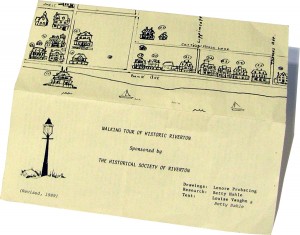![Nellie Bly exterior July 2012 [1024x683]](https://rivertonhistory.com/wp-content/uploads/2012/07/Nellie-Bly-exterior-July-2012-1024x683-300x200.jpg) The Historical Society of Riverton’s June meeting ended with a stop at Nellie Bly’s Ice Cream Parlour. By the time members had covered on foot the route of a seventeen-stop walking tour, they were ready to sit down and relax with one of the shop’s refreshing treats.
The Historical Society of Riverton’s June meeting ended with a stop at Nellie Bly’s Ice Cream Parlour. By the time members had covered on foot the route of a seventeen-stop walking tour, they were ready to sit down and relax with one of the shop’s refreshing treats.
![DSC00420 [1024x683]](https://rivertonhistory.com/wp-content/uploads/2012/07/DSC00420-1024x683-300x200.jpg) We planned that last meeting before our summer hiatus as a practice run for the recently revised Walking Tour of Historic Riverton. (See related story here.) President Gerald Weaber called the meeting to order at 7:00 p.m. in the Riverton School Media Center and dealt with several Society matters before adjourning to the outdoors.
We planned that last meeting before our summer hiatus as a practice run for the recently revised Walking Tour of Historic Riverton. (See related story here.) President Gerald Weaber called the meeting to order at 7:00 p.m. in the Riverton School Media Center and dealt with several Society matters before adjourning to the outdoors.
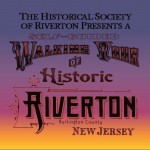 The group watched a short slide show to introduce the planned activity–with a draft copy of the Walking Tour in hand, we were to hike the course and scrutinize it for errors of any kind so that we can get copies printed and make them available.
The group watched a short slide show to introduce the planned activity–with a draft copy of the Walking Tour in hand, we were to hike the course and scrutinize it for errors of any kind so that we can get copies printed and make them available.
The link for the PowerPoint slide show is here.
![DSC00425 [1024x682]](https://rivertonhistory.com/wp-content/uploads/2012/07/DSC00425-1024x682-300x199.jpg) Gerald hosted a parallel tour on a bus provided by Riverview Estates for the convenience of Riverview residents and any Society members who did not care to walk. Among the thirteen passengers was a 102 year-old former employee of Campbell’s Soup, a fact volunteered when the bus stopped in front of 308 Main, the former home of Joseph Campbell who founded that company.
Gerald hosted a parallel tour on a bus provided by Riverview Estates for the convenience of Riverview residents and any Society members who did not care to walk. Among the thirteen passengers was a 102 year-old former employee of Campbell’s Soup, a fact volunteered when the bus stopped in front of 308 Main, the former home of Joseph Campbell who founded that company.
![Pat Brunker and crew [1024x680]](https://rivertonhistory.com/wp-content/uploads/2012/07/Pat-Brunker-and-crew-1024x680-300x199.jpg)
![Mr. Renn at 410 Main [1024x680]](https://rivertonhistory.com/wp-content/uploads/2012/07/Mr.-Renn-at-410-Main-1024x680-300x199.jpg)
It was definitely an asset to have several new faces at this Walking Tour rehearsal because much of the history of these homes and structures in Riverton is oral history– stories and anecdotes passed down by word of mouth, that may or may not remain accurate with each retelling, and are seldom found in books or documents.
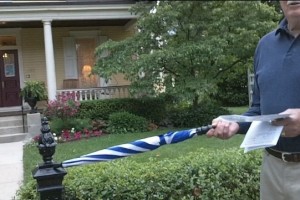
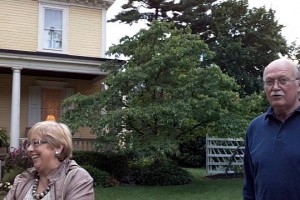
You know the danger when one assumes? Homeowner Mr. Dennis DeVries explained that although the carriage mounting block at the curb was original to the house, the cast iron hitching post and fence posts were modern reproductions. Mrs. Jan DeVries pointed out that Joseph Campbell built other homes for his children close to this one.
 Mr. and Mrs. DeVries then invited us for an impromptu tour of their garden, a gesture most appreciated by anyone who missed seeing it on the recent Porch Club Garden Tour. (See related post here.)
Mr. and Mrs. DeVries then invited us for an impromptu tour of their garden, a gesture most appreciated by anyone who missed seeing it on the recent Porch Club Garden Tour. (See related post here.)
This illustrates why the best authorities about these homes are the residents themselves as I found out when I spoke to Mr. Keith Betten previously while I tried to reconcile some contradictions between dates on house signs and dates on the old Walking Tour brochure.
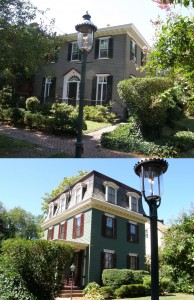
Mr. Betten, the current owner of 404 Main Street, explained how he researched his deed and that he had found the signature of Edward Pancoast, the home’s first owner, scrawled on a wall inside an upstairs closet. I knew that Pancoast had designed and built 404 and 402 Main, but Keith showed me why his home and 402 Main, next door, are “sister” houses–the exteriors and roof lines may seem different, but the floor plans are identical. I had not seen that before.
As Mr. Betten invited me to see the splendid English garden at the rear of the home he explained that the driveway just outside the gate afforded Charles Flanagan, a later owner of the home, access to the Riverton Lyceum which once stood at Fourth and Main where he served as secretary and treasurer.
![301 Main, the house where the Duster was born [1024x680]](https://rivertonhistory.com/wp-content/uploads/2012/07/301-Main-the-house-where-the-Duster-was-born-1024x680-300x199.jpg)
Another one I heard the night of the meeting that I must try to verify was about a Riverton homeowner who cut into an interior wall in his house because he was perplexed that the wall dimensions did not make sense with the room, only to find a hidden liquor still within the space. Whaaaat???
![new walking tour [512x768]](https://rivertonhistory.com/wp-content/uploads/2012/07/new-walking-tour-512x768-200x300.jpg) Such stories only grow more faint with the passage of time. If you would care to share any facts or stories which may help us in compiling information for other walking tours, please contact us with your ideas.
Such stories only grow more faint with the passage of time. If you would care to share any facts or stories which may help us in compiling information for other walking tours, please contact us with your ideas.
It turns out that the group did catch a few errors. After a few minor fixes to the text and renumbering several map locations we were ready to go to press.
You can see the finished result at the New Leaf where copies of this first Walking Tour of Historic Riverton are available for $1.00. Other tours in the series will include Riverton Yacht Club and homes along the river, homes along Carriage House Lane, as well as locations south of the railroad tracks. We hope to design a separate children’s version and possibly offer a means for smartphone owners to access additional information from our website. – John McCormick, Gaslight News editor
Rev. Feb. 2016: The New Leaf no longer has copies. Check Riverton Library. Four years later, no more progress has been achieved on this since 2012. Big plans, not enough hands. – JMc
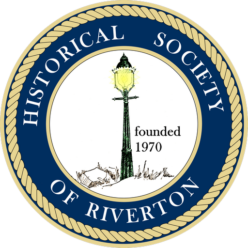
![Treasure Day 2012_1 [1600x664]](https://rivertonhistory.com/wp-content/uploads/2012/05/Treasure-Day-2012_1-1600x664-1024x424.jpg)
